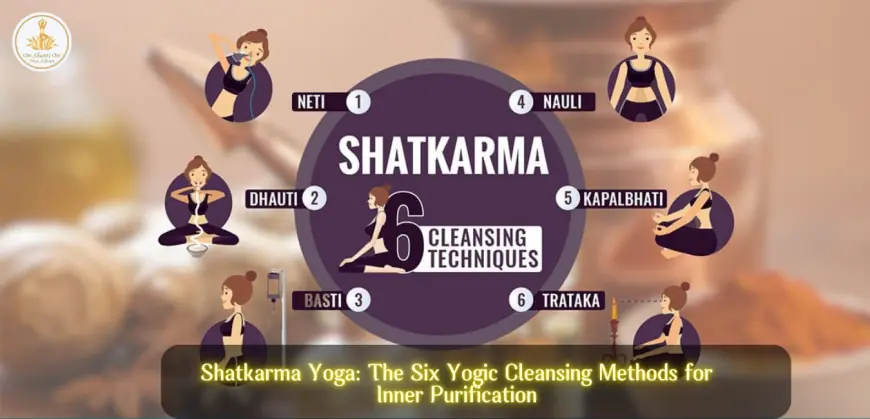Shat Kriyas in Yoga: The Ancient Cleansing Techniques for Body and Mind
Yoga is widely known for its postures (asanas) and breath control (pranayama), but a lesser-known yet equally important part of traditional yogic practice is shat kriyas in yoga. Also referred to as shat karmas, these are six powerful purification techniques designed to cleanse the internal organs, improve health, and prepare the practitioner for deeper spiritual practices.
In Sanskrit, "shat" means six, and "kriya

" means action or practice. Therefore, shat kriyas in yoga refer to the six actions or cleansing techniques that help remove toxins from the physical and subtle body. These practices are described in classical yogic texts such as the Hatha Yoga Pradipika and the Gheranda Samhita.
Why Are Shat Kriyas Important in Yoga?
The goal of yoga is not just physical fitness but also mental clarity, emotional balance, and spiritual growth. However, accumulated toxins—both physical and mental—can block the flow of prana (life force energy). This is where shat kriyas in yoga play a vital role.
By regularly practicing these cleansing techniques, one can:
-
Detoxify the internal organs
-
Enhance the efficiency of bodily systems
-
Improve digestion and respiratory function
-
Sharpen concentration and mental clarity
-
Prepare the body for advanced practices like pranayama and meditation
The Six Shat Kriyas in Yoga
Here is a breakdown of the six classical cleansing techniques:
1. Dhauti (Cleansing of the Digestive Tract)
Dhauti is a group of practices designed to clean the stomach and esophagus. One common method is Vamana Dhauti or Kunjal Kriya, where lukewarm saline water is consumed and then voluntarily vomited to flush out the stomach.
-
Benefits: Removes excess mucus, relieves acidity, and purifies the upper digestive tract.
-
Precaution: Should be done under guidance, especially for beginners.
2. Basti (Yogic Enema)
Basti cleanses the colon and rectum. Traditionally, it was performed by sitting in water and drawing it into the colon through muscular control. Modern versions use a rubber tube and water or herbal solutions.
-
Benefits: Eliminates toxins from the lower digestive tract, improves bowel movements, and helps in the treatment of constipation.
-
Types: Jala Basti (with water), Sthala Basti (dry method using air).
3. Neti (Nasal Cleansing)
Neti is one of the most widely practiced shat kriyas in yoga. It involves cleansing the nasal passages with warm saline water (Jala Neti) using a special Neti pot. There is also Sutra Neti, which uses a soft rubber or cotton thread.
-
Benefits: Clears nasal passages, reduces sinus issues, improves breathing, and enhances mental clarity.
-
Precaution: Always use clean, sterile equipment and water.
4. Trataka (Yogic Gazing)
Trataka involves focused gazing at a single point, such as a candle flame, without blinking. It is both a cleansing and a meditative practice.
-
Benefits: Strengthens the eyes, improves concentration, and calms the mind.
-
Spiritual Value: Prepares the mind for deeper meditation and develops inner vision.
5. Nauli (Abdominal Churning)
Nauli is an advanced practice that involves massaging the abdominal organs by contracting and rotating the abdominal muscles.
-
Benefits: Stimulates digestion, strengthens abdominal muscles, balances the nervous system, and massages internal organs.
-
Note: It requires proper guidance and should be learned from an experienced teacher.
6. Kapalabhati (Skull-Shining Breath)
Although often considered a pranayama, Kapalabhati is listed among the shat kriyas in yoga due to its cleansing effect. It involves short, forceful exhalations and passive inhalations.
-
Benefits: Detoxifies the lungs, increases oxygen supply, boosts energy, and clears the mind.
-
Daily Practice: Commonly practiced in modern yoga sessions due to its energizing effect.
Who Should Practice Shat Kriyas?
Shat kriyas in yoga are ideal for:
-
Yoga practitioners aiming for deeper spiritual growth
-
People suffering from digestive or respiratory issues
-
Anyone experiencing sluggishness, brain fog, or low energy
However, these practices are not for everyone. They should be avoided by:
-
Pregnant women
-
People with high blood pressure or heart conditions
-
Those recovering from surgeries or serious illness
Always consult a qualified yoga teacher or therapist before beginning these techniques.
How Often Should You Practice Shat Kriyas in Yoga?
Not all kriyas are meant for daily practice. Some, like Kapalabhati or Trataka, can be done regularly. Others, like Vamana Dhauti or Basti, are typically done weekly or monthly, depending on your constitution and health goals.
Conclusion
Incorporating shat kriyas in yoga into your routine can bring remarkable changes—not only to your physical health but also to your mental and emotional well-being. These ancient cleansing techniques prepare the body as a pure vessel for higher yogic practices and deeper states of meditation.
Whether you are a beginner or an advanced yoga practitioner, exploring the shat kriyas in yoga can deepen your understanding and experience of yoga as a holistic path.
What's Your Reaction?
 Like
0
Like
0
 Dislike
0
Dislike
0
 Love
0
Love
0
 Funny
0
Funny
0
 Angry
0
Angry
0
 Sad
0
Sad
0
 Wow
0
Wow
0
















































